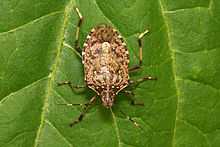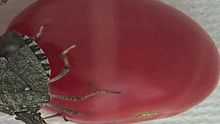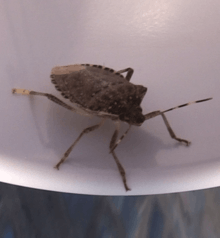Brown marmorated stink bug
| Brown marmorated stink bug | |
|---|---|
 | |
| Adult female | |
| Conservation status | |
| Not Evaluated | |
| Scientific classification | |
| Kingdom: | Animalia |
| Phylum: | Arthropoda |
| Class: | Insecta |
| Order: | Hemiptera |
| Family: | Pentatomidae |
| Genus: | Halyomorpha |
| Species: | H. halys |
| Binomial name | |
| Halyomorpha halys Stål, 1855[1] | |
Halyomorpha halys, also known as the brown marmorated stink bug (BMSB), or simply the stink bug, is an insect in the family Pentatomidae, and it is native to China, Japan and Taiwan.[2] It was accidentally introduced into the United States, with the first specimen being collected in September 1998.[3] The brown marmorated stink bug is considered to be an agricultural pest,[4] and by 2010–11 had become a season-long pest in U.S. orchards.[5]
Description
The adults are approximately 1.7 centimetres (0.67 in) long and about as wide, forming the shield shape characteristic of other stink bugs. They are various shades of brown on both the top and undersides, with gray, off-white, black, copper, and bluish markings. Markings unique to this species include alternating light bands on the antennae and alternating dark bands on the thin outer edge of the abdomen. The legs are brown with faint white mottling or banding. The stink glands are located on the underside of the thorax, between the first and second pair of legs, and on the dorsal surface of the abdomen.[6]
Behavior

The brown marmorated stink bug is an agricultural pest that can cause widespread damage to fruit and vegetable crops. In Japan it is a pest to soybean and fruit crops. In the U.S., the brown marmorated stink bug feeds, beginning in late May or early June, on a wide range of fruits, vegetables, and other host plants including peaches, apples, green beans, soybeans, cherries, raspberries, and pears. It is a sucking insect, a "true bug", that uses its proboscis to pierce the host plant in order to feed. This feeding results, in part, in the formation of dimpled or necrotic areas on the outer surface of fruits, leaf stippling, seed loss, and possible transmission of plant pathogens.
The brown marmorated stink bug is more likely to invade homes in the fall than others in the family.[7] The bug survives the winter as an adult by entering houses and structures when autumn evenings become colder, often in the thousands. In one home more than 26,000 stinkbugs were found overwintering.[8] Adults can live from several months to a year.[9][10] They will enter under siding, into soffits, around window and door frames, chimneys, or any space which has openings big enough to fit through. Once inside the house, they will go into a state of hibernation. They wait for winter to pass, but often the warmth inside the house causes them to become active, and they may fly clumsily around light fixtures. According to a peer-reviewed article in PLOSone (see external links, below) two important vectors of this pest are landscape ornamentals: Tree of Heaven, and Princess Tree. If possible, these ornamentals should be removed. NB: other shield-shaped bugs (such as the anchor bug) are beneficials, eating, for example, Japanese beetles, and Mexican bean beetles, according to a Wikipedia article on Pentatomidae.
The odor from the stink bug is due to trans-2-decenal and trans-2-Octenal.[11] The smell has been characterized as a "pungent odor that smells like coriander."[5]
The stink bug's ability to emit an odor through holes in its abdomen is a defense mechanism meant to prevent it from being eaten by birds and lizards. However, simply handling the bug, injuring it, or attempting to move it can trigger it to release the odor.
In the United States
The brown marmorated stink bug was accidentally introduced into the United States from China or Japan. It is believed to have hitched a ride as a stowaway in packing crates. The first documented specimen was collected in Allentown, Pennsylvania, in September 1998.[4][12] Several Muhlenberg College students were reported to have seen these bugs as early as August of that same year.[7][13]
Other reports have the brown marmorated stink bug recovered as early as 2000 in New Jersey from a black light trap run by the Rutgers Cooperative Extension (RCE) Vegetable Integrated Pest Management program in Milford, New Jersey. [14] In 2002, it was again collected in New Jersey from black light traps located in Phillipsburg and Little York and was found on plant material in Stewartsville. It was quickly documented and established in many counties in Pennsylvania, New Jersey, Delaware, Connecticut and New York on the eastern coast of the United States. By 2009, this agricultural pest had reached Maryland, West Virginia, Virginia, Tennessee, North Carolina, Kentucky, Ohio, Illinois, and Oregon.[15] In 2010 this pest was found in additional states including Indiana,[16] Michigan,[17] Minnesota,[18] and other states.[19] As of November 2011 it has spread to 34 U.S. states[5] and by 2012 to 40 and showed an increase of 60% in total numbers over 2011.[20]
Population increase

Higher than normal numbers of stink bugs were reported in the eastern half of the United States in 2010.[21] The following are some of the possible reasons for the dramatic population increase:
- Stink bugs typically have four generations per growing season in Asia, and one after transplantation to the U.S., but an unusually warm and early spring and summer in 2010 allowed them to produce two additional generations in regions like Maryland and Northern Virginia.[22][23]
- The extra generations means that some states are seeing more bugs in more places than in previous seasons. Adults are living longer, depositing eggs longer and maturing more generations to lay even more eggs.
The higher than normal population has caused some of the following environmental problems:
- The insects have started attacking fruit and trees in orchards in southern and eastern Pennsylvania, which had not been seen in previous years.
- Bugs pierce the fruit’s outer surface and suck out juices while injecting saliva. The suction and saliva create a dimpling of the fruit’s surface, and rotting and corking of the flesh underneath.
- The fruit is not salable because of appearance although the dimpled area is not poisonous to humans.
- The bugs attack numerous types of plants—including tomatoes, soy beans, lima beans and sweet corn—but fruit show the damage more quickly and orchard owners monitor for damage more closely. Little is known about what these insects do in the wild.
Control
Control of stink bugs is a priority of the Department of Agriculture which has developed an artificial pheromone which can be used to bait traps. Because the bugs insert their proboscis below the surface of fruit, and then feed, some insecticides are ineffective; in addition, the bugs are mobile, and a new population may fly in after the resident population has been killed. In the case of soybean infestations research shows that spraying only the perimeter of a field may be effective. As of 2012, native predators such as wasps and birds were showing increased signs of feeding on the bugs as they adapt to the new food source.[20]
Similarity in appearance to native species
Easily confused with Brochymena and Euschistus, the best identification for adults is the white band on the antennae. It is similar in appearance to other native species of shield bug including Acrosternum, Euschistus, and Podisus, except that several of the abdominal segments protrude from beneath the wings and are alternatively banded with black and white (visible along the edge of the bug even when wings are folded) and a white stripe or band on the next to last (4th) antennal segment.[24] The adult rice stink bug (Oebalus pugnax) is distinguishable from the brown marmorated stink bug by noting the straw color, the smaller size, and the elongated shape of the rice stink bug.[25]
Predators
In China, Trissolcus japonicus,[26] a parasitoid wasp species in the family Scelionidae, is a primary predator.[27] This species is not currently present in the U.S., but is undergoing study for possible introduction.[5] Several other species of the parasitoid wasp have been documented attacking stink bug eggs in a Virginia soybean field.[28]
Gallery
See also
- Stink bug
- Acrosternum hilare, the green stink bug
- Nezara viridula, the southern green stink bug
- Oebalus pugnax, the rice stink bug
References
- ↑ Wermelinger, Beat; Denise Wyniger; Beat Forster. 2008. First records of an invasive bug in Europe: Halyomorpha halys Stål (Heteroptera: Pentatomidae), a new pest on woody ornamentals and fruit trees? Mitteilungen der Schweizerischen Entomologischen Gesellschaft: Bulletin de la Société Entomologique Suisse 81: 1–8.
- ↑ "Brown Marmorated Stink Bug". Pennsylvania State University. Retrieved 2011-05-25.
- ↑ Jacobs, Steve (September 2010). Brown Marmorated Stink Bug — Entomology — Penn State University:. State College, PA: Penn State University College of Agricultural Sciences. Retrieved October 21, 2010.
- ↑ 4.0 4.1 "Move Over, Bedbugs: Stink Bugs Have Landed". New York Times. September 26, 2010. Retrieved 2010-09-28.
Government and university researchers say they need more time to study the bug, which has been in the United States since about 1998. Native to Asia, it was first found in Allentown, Pa., and has no natural enemies here.
- ↑ 5.0 5.1 5.2 5.3 "Stink Bug Invasion: Is a Wasp the Solution to Save Valued Crops?". PBS NewsHour. May 24, 2011. Retrieved 2011-05-25.
- ↑ Jacobs, Steven B. (May 2009). "Entomological Notes: Brown Marmorated Stink Bug" (PDF). Pennsylvania State University Department of Agriculture. Retrieved July 1, 2011.
- ↑ 7.0 7.1 Gyeltshen J, Bernon G, Hodges A. (July 2010). "Brown Marmorated Stink Bug, Halyomorpha halys Stål (Insecta: Hemiptera: Pentatomidae)". University of Florida, IFAS. Retrieved 2008-10-25.
- ↑ Inkley DB, 2012. Characteristics of home invasion by the brown marmorated stink bug (Hemiptera: Pentatomidae). Journal of Entomological Science, 47(2):125–130.
- ↑ Meacham, Jennifer (October 5, 2010). "Asian stink bugs invade Oregon". KATU News. Retrieved 27 April 2011.
- ↑ Marchiando, Collin. "Monitoring for the Brown Marmorated Stink Bug: Frequently Asked Questions". Rutgers University, New Jersey Agricultural Experiment Station. Retrieved 27 April 2011.
- ↑ Henderson, Will; Khalilian, Ahmad; Han, Young (9–12 July 2006). Detecting Stink Bugs/Damage in Cotton Utilizing a Portable Electronic Nose (PDF). Oregon Convention Center; Portland, Oregon: Clemson University. Retrieved March 24, 2010.
- ↑ "Penn State University extension site on the insect". ento.psu.edu. Retrieved 2010-09-23.
- ↑ Invasive.org; Lance, David R.; Pennsylvania Department of Conservation and Natural Resources Forestry Archive; Bernon, Gary. "brown marmorated stink bug". Invasive.org is a joint project of The Bugwood Network, USDA Forest Service and USDA APHIS PPQ. Retrieved 2008-10-25.
- ↑ "Monitoring for the Brown Marmorated Stink Bug". Rutgers, The State University of New Jersey.
- ↑ LaBonte, James (November 2, 2009). "Brown Marmorated Stink Bug". ODA Plant Division, Insect Pest Prevention and Management; Report. Oregon Department of Agriculture. Retrieved March 26, 2010.
- ↑ "Brown Marmorated Stink Bug: Potentially Serious Pest Found in Indiana". Purdue University. Retrieved 2011-05-25.
- ↑ "State Ag. Department Confirms Brown Marmorated Stink Bug in Michigan". State of Michigan. 2011-02-01. Retrieved 2011-05-25.
- ↑ "Brown Marmorated Stink Bug". Minnesota Department of Agriculture. Retrieved 2011-05-25.
- ↑ "Pest Tracker". Purdue University. Retrieved 2011-05-25.
- ↑ 20.0 20.1 Darryl Fears (May 26, 2013). "Scientists wage war on pervasive stink bugs". The Washington Post. Retrieved May 27, 2013.
- ↑ "On the Trail of the Stink Bug". Penn State University College of Agricultural Sciences.
- ↑ Day, Eric (24 February 2011). "Brown marmorated stink bug" (PDF). Virginia Tech. Retrieved 23 September 2011.
- ↑ Sutphin, Michael (25 July 2011). "Virginia's tree fruit industry has new insecticide to fight stink bugs". Virginia Tech News. Virginia Tech University. Retrieved 22 September 2011.
- ↑ Bessin, Ric. "Brown Marmorated Stink Bug Look-A-Likes in Kentucky" (PDF). Retrieved 2011-05-25.
- ↑ "Rice Stink Bug (Oebalus pugnax)". Louisiana State University AgCenter. Retrieved 2012-04-08.
- ↑ Talamas EJ, Buffington M, Hoelmer K (2013) New synonymy of Trissolcus halyomorphae Yang. Journal of Hymenoptera Research 33: 113–117. doi: 10.3897/JHR.33.5627
- ↑ Pfeiffer, Douglas G. (March 30, 2009). "Brown Marmorated Stink Bug". Fact Sheet. Virginia Tech Department of Entomology. Retrieved February 24, 2011.
- ↑ Roberson, Roy (November 20, 2009). "Natural predators tested for stink bug control". News article. southeast Farm Press. Retrieved March 30, 2009.
Further reading
- Rice, Kevin B.; Bergh, Chris J.; Bergmann, Erik J.; Biddinger, Dave J.; Dieckhoff, Christine; Dively, Galen; Fraser, Hannah; Gariepy, Tara; Hamilton, George; Haye, Tim; Herbert, Ames; Hoelmer, Kim; Hooks, Cerruti R.; Jones, Ashley; Krawczyk, Greg; Kuhar, Thomas; Martinson, Holly; Mitchell, William; Nielsen, Anne L.; Pfeiffer, Doug G.; Raupp, Michael J.; Rodriguez-Saona, Cesar; Shearer, Peter; Shrewsbury, Paula; Venugopal, P. Dilip; Whalen, Joanne; Wiman, Nik G.; Leskey, Tracy C.; Tooker, John F. (2014). "Biology, ecology, and management of brown marmorated stink bug (Hemiptera: Pentatomidae)". Journal of Integrated Pest Management 5 (3): A1–A13. doi:10.1603/IPM14002.
- Khrimian, Ashot; Shearer, Peter W.; Zhang, Aijun; Hamilton, George C.; Aldrich, Jeffrey R. (2008). "Field Trapping of the Invasive Brown Marmorated Stink Bug, Halyomorpha halys, with Geometric Isomers of Methyl 2,4,6-Decatrienoate". Journal of Agricultural and Food Chemistry 56 (1): 197–203. doi:10.1021/jf072087e. PMID 18069789.
- Funayama, Ken (2004). "Importance of apple fruits as food for the brown-marmorated stink bug, Halyomorpha halys (Stal) (Heteroptera: Pentatomidae)". Applied Entomology and Zoology 39 (4): 617. doi:10.1303/aez.2004.617.
- Nielsen, Anne L.; Hamilton, George C. (2009). "Life History of the Invasive Species Halyomorpha halys (Hemiptera: Pentatomidae) in Northeastern United States". Annals of the Entomological Society of America 102 (4): 608. doi:10.1603/008.102.0405.
- Aldrich, J. R.; Khrimian, A.; Chen, X.; Camp, M. J. (2009). "Semiochemically Based Monitoring of the Invasion of the Brown Marmorated Stink Bug and Unexpected Attraction of the Native Green Stink Bug (Heteroptera: Pentatomidae) in Maryland". Florida Entomologist 92 (3): 483. doi:10.1653/024.092.0310.
- Toyama, Masatoshi; Ihara, Fumio; Yaginuma, Katsuhiko (2006). "Formation of aggregations in adults of the brown marmorated stink bug, Halyomorpha halys (Stål) (Heteroptera: Pentatomidae): The role of antennae in short-range locations". Applied Entomology and Zoology 41 (2): 309. doi:10.1303/aez.2006.309.
- Nielsen, Anne L.; Shearer, Peter W.; Hamilton, George C. (2008). "Toxicity of Insecticides to Halyomorpha halys (Hemiptera: Pentatomidae) Using Glass-Vial Bioassays". Journal of Economic Entomology 101 (4): 1439–42. doi:10.1603/0022-0493(2008)101[1439:TOITHH]2.0.CO;2. PMID 18767758.
- Lee, Wonhoon; Kang, Joongnam; Jung, Chansik; Hoelmer, Kim; Lee, Si Hyeock; Lee, Seunghwan (2009). "Complete mitochondrial genome of brown marmorated stink bug Halyomorpha halys (Hemiptera: Pentatomidae), and phylogenetic relationships of hemipteran suborders". Molecules and Cells 28 (3): 155–65. doi:10.1007/s10059-009-0125-9. PMID 19756390.
- Yang, Zhong-Qi; Yao, Yan-Xia; Qiu, Lan-Fen; Li, Zhong-Xin (2009). "A New Species of Trissolcus (Hymenoptera: Scelionidae) Parasitizing Eggs of Halyomorpha halys (Heteroptera: Pentatomidae) in China with Comments on Its Biology". Annals of the Entomological Society of America 102: 39. doi:10.1603/008.102.0104.
External links
| Wikimedia Commons has media related to Halyomorpha halys. |
- Wikibooks: Halyomorpha halys
- Stink bug fact sheet Penn State Fact Sheet on the brown marmorated stink bug
- brown marmorated stink bug on the UF/IFAS Featured Creatures Web site
- Brown marmorated stink bug in Oregon
- brown marmorated stink bug at Invasive.org a joint project of The Bugwood Network, USDA Forest Service and USDA APHIS PPQ
- Species Profile- Brown Marmorated Stink Bug (Halyomorpha halys), National Invasive Species Information Center, United States National Agricultural Library. Lists general information and resources for brown marmorated stink bug.
- at PLOSone.












